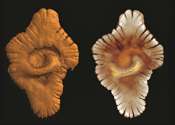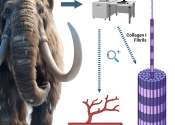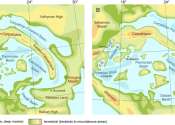Last update:
Paleontology & Fossils news

The first farmers often made landscapes more biodiverse, providing lessons for rewilding today
You don't need to read the news or scroll through Instagram for long to stumble across the latest example of a rare and beautiful species that has gone extinct. Since AD1500, at least 705 vertebrate species and 571 plant ...
Ecology
Jul 29, 2024
0
28

New species of tyrannosaurid dinosaur identified in China
A team of paleontologists at the Zhejiang Museum of Natural History in China reports a new species of tyrannosaurid dinosaur. Their find is published in the journal Scientific Reports.

Complex life on Earth began around 1.5 billion years earlier than previously thought, new study claims
Environmental evidence of the very first experiments in the evolution of complex life on Earth, has been uncovered by an international team of scientists.
Paleontology & Fossils
Jul 29, 2024
0
384

Komodo dragons have iron-coated teeth to rip apart their prey, researchers find
Scientists have discovered that the serrated edges of Komodo dragons' teeth are tipped with iron. Led by researchers from King's College London, the study gives new insight into how Komodo dragons keep their teeth razor-sharp ...
Plants & Animals
Jul 27, 2024
0
28

3D models show dolphins already used narrow-band sound waves for orientation 5 million years ago
Senckenberg researcher Dr. Rachel Racicot and her former student Joyce Sanks from Vanderbilt University have examined the inner ear of the extinct dolphin genus Parapontoporia. In their study, published in the journal The ...
Evolution
Jul 26, 2024
0
128

A soft needle in an oceanic haystack: Scientists discover a new species of chordate
The Cambrian fossil record indicates that most animal phyla had diversified and inhabited the Earth's oceans approximately 518 million years ago. But even though chordates—the group that includes vertebrates like humans—were ...
Evolution
Jul 25, 2024
0
215

AI-assisted analysis suggests elephant-like species extinction rates grew when humans arrived
A pair of paleobiologists at the University of Fribourg and Swiss Institute of Bioinformatics, in Switzerland, working with a colleague from Museo Nacional de Ciencias Naturales, in Spain, has found evidence suggesting that ...

Isle of Skye discovery suggests ancient mammals had longer lifespans than modern counterparts
A team of paleontologists and natural science specialists from the U.K., the U.S. and France reports that ancient fossil evidence uncovered on Scotland's Isle of Skye suggests small mammals living millions of years ago may ...

Ancient marine animal had inventive past despite being represented by few species, new study finds
Brachiopods were evolving in new directions but this did not become an evolutionary success in terms of the numbers of species, researchers at the University of Bristol, the Open University, and the China University of Geosciences ...
Evolution
Jul 25, 2024
0
72

Scientists assess how large dinosaurs could really get
A new study by Dr. Jordan Mallon of the Canadian Museum of Nature in Ottawa, Canada and Dr. David Hone of Queen Mary University of London, U.K., looks at the maximum possible sizes of dinosaurs. It is published in the journal ...
Paleontology & Fossils
Jul 24, 2024
0
72

Taco-shaped arthropod fossils give new insights into the history of the first mandibulates
A new study, led by paleontologists at the Royal Ontario Museum (ROM) is helping resolve the evolution and ecology of Odaraia, a taco-shaped marine animal that lived during the Cambrian period.
Evolution
Jul 23, 2024
0
235

Nanoscopic imaging aids in understanding protein, tissue preservation in ancient bones
A pilot study from North Carolina State University shows that nanoscopic 3D imaging of ancient bone not only provides further insight into the changes soft tissues undergo during fossilization, it also has potential as a ...
Biotechnology
Jul 22, 2024
0
125

Museum collections indicate Central Europe was a global biodiversity hotspot 15 million years ago
The collections of natural history museums are unique archives of evolution. They allow us to look far into the geological past. Shells of marine snails are particularly common fossils and are well suited to reconstructing ...
Paleontology & Fossils
Jul 22, 2024
0
128

New fossil snake species provides insight into reptile social behavior and development
A newly discovered snake species, Hibernophis breithaupti, provides rare insight into the social behavior of snakes and fills some gaps in our knowledge of the evolution of boas, or boidae. The quartet of fossilized snakes ...
Paleontology & Fossils
Jul 18, 2024
0
300

Stegosaurus fossil fetches nearly $45M, setting record for dinosaur auctions
The nearly complete fossilized remains of a stegosaurus fetched $44.6 million at auction Wednesday, Sotheby's said. The buyer's name was not disclosed.
Paleontology & Fossils
Jul 18, 2024
38
8

Evidence for butchery of giant armadillo-like mammals in Argentina 21,000 years ago
Cut marks on fossils could be evidence of humans exploiting large mammals in Argentina more than 20,000 years ago, according to a study published July 17, 2024 in the open-access journal PLOS ONE by Mariano Del Papa of National ...
Paleontology & Fossils
Jul 17, 2024
0
466

Research tracks 66 million years of mammalian diversity
When trying to understand the present, it's helpful to look to history. New research from the University of Nebraska–Lincoln examined the fossil record going back 66 million years and tracked changes to mammalian ecosystems ...
Ecology
Jul 17, 2024
0
198

Brazilian researchers discover dinosaur fossil after heavy rains in Rio Grande do Sul
A team of Brazilian scientists has discovered a fossilized skeleton of what they believe is one of the world's oldest dinosaurs after heavy rains in the southern state of Rio Grande do Sul accelerated the natural process ...
Paleontology & Fossils
Jul 17, 2024
0
160

How old are South African fossils like the Taung Child? Study offers an answer
One hundred years ago, the discovery of a skull in South Africa's North West province altered our understanding of human evolution. The juvenile skull was dubbed the Taung Child by Raymond Dart, an anatomist at the University ...
Paleontology & Fossils
Jul 15, 2024
0
140

Gnatalie is the only green-boned dinosaur found on the planet. She will be on display in LA
The latest dinosaur being mounted at the Natural History Museum in Los Angeles is not only a member of a new species—it's also the only one found on the planet whose bones are green, according to museum officials.
Paleontology & Fossils
Jul 14, 2024
1
383
More news

3D genome extracted from 'freeze-dried' woolly mammoth

First ever 3D reconstruction of 52,000-year-old woolly mammoth chromosomes thanks to serendipitously freeze-dried skin

Stegosaurus skeleton to fetch millions at New York auction

A new species of extinct crocodile relative rewrites life on the Triassic coastline

Research reveals the most complete dinosaur discovered in the UK in a century

Australian amber has revealed 'living fossils' traced back to Gondwana 42 million years ago

Life underground suited newly discovered dinosaur, study finds

Fossils show huge salamanderlike predator with sharp fangs existed before the dinosaurs

Giant salamander-like creature was a top predator in the ice age before the dinosaurs

Team plans 3D modeling project for France's natural history collections

An Arizona museum tells the stories of ancient animals through their fossilized poop

Fossil insects help to reconstruct the past—how I ended up studying them (and you can too)
Other news

Study identifies universal blueprint for mammalian brain shape

Engineers use machine learning to measure chaos in systems

Researchers discover high levels of non-coding RNAs in testes, suggesting new roles in sperm function and evolution

New York's Long Island Sound acidifies during droughts

Elusive predicted water structure created in the laboratory

Parasite engineered to deliver therapy proteins to nerve cells

Acceptance seen as a key to 'financial mindfulness'

Researchers create a cell atlas of the regenerating liver

Study finds linguistic similarity boosts cooperation

Developing new methods for targeted protein degradation

Ammonites' fate sealed by meteor strike that wiped out dinosaurs

Last surviving woolly mammoths were inbred but not doomed to extinction, genomic analysis suggests

Earliest evidence of cave lions in southern Europe discovered

New study finds dinosaur fossils did not inspire the mythological griffin

New, small, ancient crocodile-like reptile described in Brazil










































